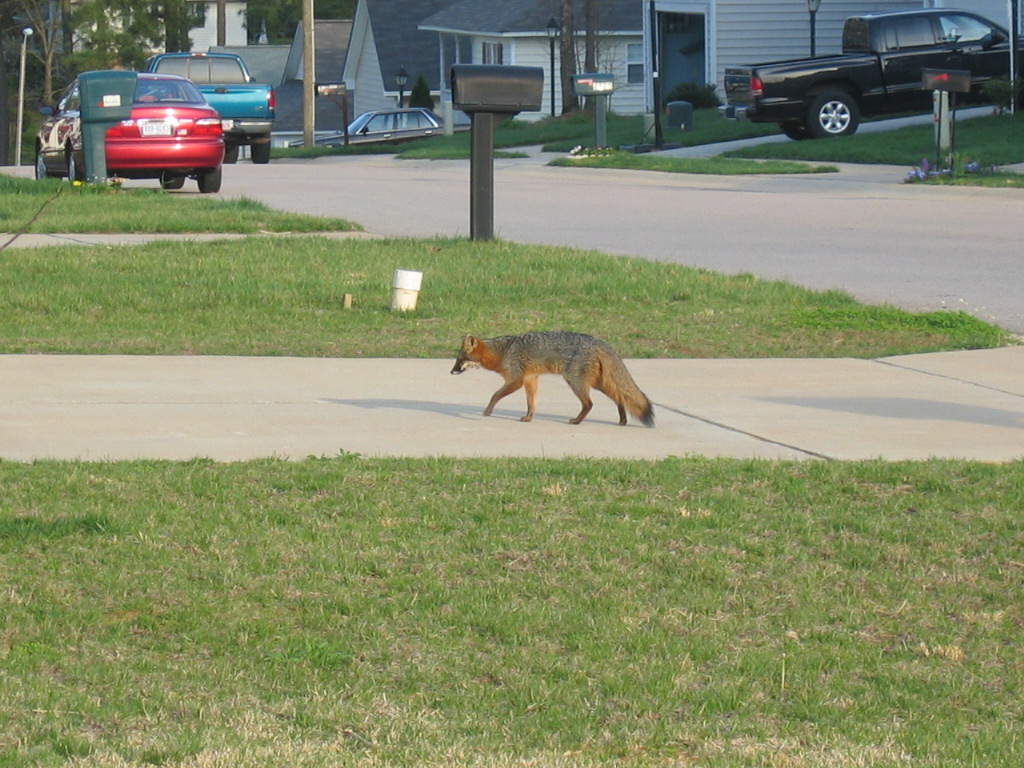Sometimes, in the twilight hours of the day, a small, cat-like animal can be seen scampering across a street, front yard or parking lot. By the time your eyes focus and your brain responds to what you saw — or thought you saw — it’s gone.
What you probably saw was a fox.
Foxes are just as common as raccoons, possums and deer, said Chris Mooreman, an associate professor at North Carolina State University and coordinator of the college’s Fisheries, Wildlife, andConservationBiologyProgram.
Red and grey foxes — the species most often seen in Raleigh — are urban adapters, or animals that can easily adapt to an urban or suburban environment, Mooreman said.
“They have a very generalized food habits,” Mooreman said. “A fox diet could include anything from a grasshopper to a plum to cat food that’s left out on the back porch.”
Any animal that can live off food scraps will find it easy to survive in an area such as Raleigh, he said.
Which Fox?
Grey foxes are the most common type of fox found in this area. Their natural habitat consists of woodlands, as opposed to grassy fields preferred by red foxes.
Red foxes weigh in at 10 to 15 pounds and have a red coat with a white-tipped tail and black paws. Grey foxes are slightly smaller, at 7 to 13 pounds, with a red hue to their grey coat, and have a black tip on their tails.
In short, they’re about the size of cats, which is why they are often mistaken for one. Grey foxes can also climb trees, adding to their cat-like quality.

Photo by Jason Hibbets
While red foxes can be found in Raleigh, they aren’t nearly as common, most likely due to their inability to compete with coyotes.
Yup. Coyotes.
Coyotes are the third canid, or wild dog, that can be found in the City of Oaks. Mooreman said their numbers have been increasing for the past 20 years, and in his opinion, don’t seem to be leveling off. But without further studies it’s hard to determine how many coyotes live in the area.
“It’s misconception that people are pushing coyotes out or pushing foxes out,” Mooreman said. “Actually people are creating opportunities for those generalized animals.”
Thriving in Raleigh
Along with humans creating more garbage, which creates an ample food source for these animals, the way Raleigh has developed has helped foxes thrive.
“We do have an aggressive green-space conservation approach,” Mooreman said. “And the way we develop is very sprawled so it’s not concentrated urban development.”
If Raleigh continues to conserve its open space and maintain a woodland-like development approach, grey foxes will likely continue to call Raleigh home.
Urban chickens have been increasing in Raleigh, but anecdotally at least, the foxes seem to leave them alone. No daring nighttime raids into the chicken coop by the Fantastic Mr. Fox in Raleigh.
“I don’t see a relationship between backyard chickens and city foxes, as far as [chicken] losses,” said Bob Davis, chicken owner and co-founder of HensidetheBeltlineTourd’ Coop. ”Most folks build their coops predator-proofed enough to exclude foxes.”
Davis said residents leaving cat food on their back porch attracts more foxes than the chickens do. Davis lives outside the city limits, where he is visited by red and grey foxes, along with domestic dogs. He’s never lost a chicken, but his neighbor has lost some of his free-range birds.
While living in the Five Points neighborhood, Davis said he would sometimes see foxes crossing Wade Avenue, but it wasn’t often.
Mooreman agrees that the increase in residents keeping chickens has little to do with the number of foxes in the area since foxes have such a generalized diet. But he said chicken owners have the potential to see more foxes than the average resident.
Fox Safety
Despite the fact that foxes are common and have called the city home since before the state of North Carolina was founded, they still seem to evoke concern from some residents.
“It’s a very rare that we go a day without getting two or three calls about someone seeing a fox,” said Jessica Jenks, an animal control specialist. “A lot of the concerns that we get are people calling because the foxes were seen near or in a neighborhood where children are.”
Jenks said unless the fox is acting aggressive, disoriented or looks visibly sick or injured, she’s probably just passing through.
“If you’re seeing it on a daily basis you’re going to know what’s normal and what’s not for that fox,” Jenks said.
When things change, residents should call animal control immediately.
Both Jenks and Mooreman said that just because a fox is out during the day doesn’t mean it’s rabid. Since foxes raise their pups during the late spring, it’s common to see them out and about during daylight hours looking for food for their young.
But Jenks advises parents to educate themselves and their own children about animal safety. Children shouldn’t approach any unknown animal, wild or domestic, Jenks said.
“Children will see a cute, little, fluffy [baby] fox … and pick it up thinking that it’s a puppy or something and then mom comes out of the bushes just to protect her babies,” Jenks said.
Mooreman also suggests keeping garbage in sealed containers, locking up outdoor animals in protected spaces and bringing pet food in at night to lessen the likelihood that a fox will pass through your yard.
If wild animals are wrecking havoc in your backyard and you have a birdfeeder, the seeds could be the culprit. Foxes have been known to eat the seeds and the small mice that feed on them.
Mooreman has some general advice for Raleigh residents: “Treat a sighting of a fox as a special event.”
